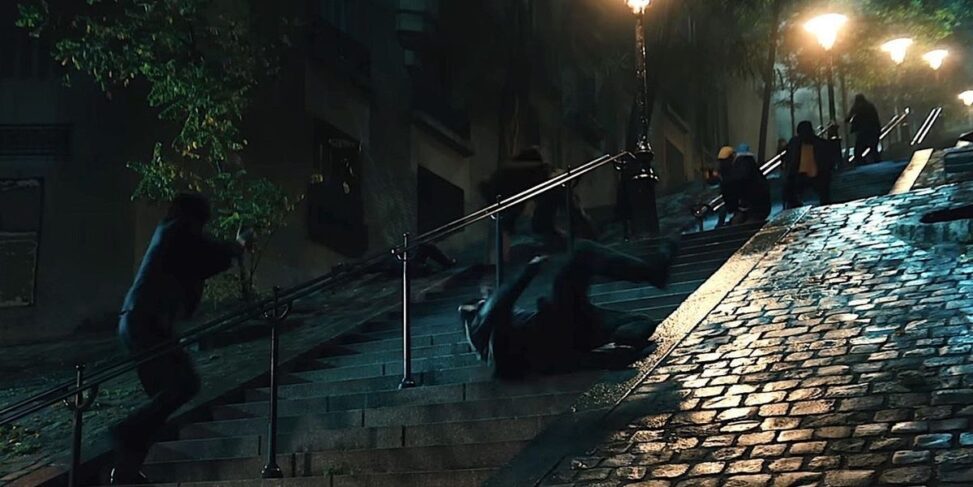The scene I chose, portrayed in the screenshot above, is the Montmartre staircase fight in John Wick: Chapter 4. In the frame I captured, Wick is partway up the stairs, fighting off multiple attackers, and looks exhausted. The lighting from the streetlamps gives the whole scene a warm glow, but the metal and stone surfaces in the frame reflect cooler tones, almost balancing out the warmth. What stood out to me is that the staircase isn’t just a background to the fight, but rather, it fundamentally shapes the dynamics and meaning of the fight. My analysis focuses on how this setting, through both its physical and visual design, transforms the fight into a struggle not only against adversaries but also against gravity and distance. The mise-en-scène really leans into this struggle by highlighting how far he still has to climb, and how many enemies are waiting to drag him down.
Because this sequence is very visually open, it’s easier to pay attention to how it’s shot and edited. In one minute, I counted about ten to fourteen cuts, which is pretty tame for a modern action movie. The camera often stays in medium or wide shots that keep Wick’s body fully visible, which makes it much easier to follow the choreography. When the camera does move, it mostly follows or glides behind him sideways up the stairs, almost like the camera is another character climbing with him. It only cuts in tightly during something like a major hit or takedown.
This style is quite different from the fast, shaky editing that’s common in a lot of Hollywood action. Film scholars have pointed out that the John Wick series goes in the opposite direction on purpose. Coulthard and Steenberg, for example, say the franchise builds its fights around the physical environments and keeps the camera clear enough that the viewer always knows where everyone is.1 That’s definitely true of this staircase scene, where the long, straight path forces a lot of forward movement and makes the fight’s structure easy to read. Anthony Luppino also talks about how some modern action movies prioritize “choreographic transparency,” meaning they show the viewer the performers’ actual movements rather than hiding them with fast edits.2 The Wick films are a good example of that approach, and you can really see it in this scene.
What also makes this sequence interesting is how it connects to the film’s global martial arts influences. Wick uses a mix of throws and gunplay, sometimes switching styles depending on the terrain. Leon Hunt writes about how modern action cinema blends different martial arts traditions into hybrid forms.3 John Wick: Chapter 4 does this constantly, but the staircase scene is one of the clearest examples because of how rhythmic the fighting feels.
The representation in this film is also worth talking about. Compared to a lot of action movies, Chapter 4 includes a diverse case of fighters – especially Caine (Donnie Yen), a blind assassin whose fighting style depends on sound cues and strategic stillness. Even though my screenshot doesn’t include Caine, his presence in the movie broadens what action-hero ability looks like. Scholars like Jordan Kern have talked about how neo-noir action films rely heavily on visual style – lighting, cityscapes, and moral ambiguity – to establish character identities.4 That definitely applies here, where Wick’s entire look (the black suit, the lighting, the urban environment) helps shape the image of him as a worn-down but still mythic figure.
At the box office, John Wick: Chapter 4 made about $432 million worldwide, which is the best in the series so far. That doesn’t just show the popularity of the character – it also shows that audiences are responding to this kind of action filmmaking, where the emphasis is on clarity and physicality instead of pure spectacle.
As far as real-life effects go, scholars generally don’t agree on one clear answer. Some research suggests that highly stylized violence can cause viewers to become somewhat desensitized over time, while others argue that because the Wick films are so obviously choreographed and exaggerated, the violence feels more like a performance than something meant to be imitated. There’s also been discussion about how the franchise highlights stunt work and physical labor, which may affect how people think about action movies and what goes into making them.5 Personally, I think most viewers can tell the difference between stylized movie violence and real life, especially when the fighting is over-the-top.
Overall, the staircase sequence from John Wick: Chapter 4 shows how the movie uses space, lighting, and camera movement to build action that feels intense but also clear and readable. This film fits well into the academic discussions about modern action cinema, especially the idea that audiences want to see performers actually perform rather than be overwhelmed by pure editing. The franchise has developed a very recognizable style by this point, and this scene is one of the best examples of how that style works.
Bibliography
1. Bould, Mark. Action Cinema. London: Wallflower Press, 2005.
2. Coulthard, Lisa, and Melek Göregenli Steenberg. “The Red Circle of Revenge: Anatomy of the Fight Sequence in John Wick.” Film Matters 13, no. 2 (2022): 1–12.
https://radar.brookes.ac.uk/radar/file/3477ac1a-2fc9-4a07-af37-b1b2462fe7c4/1/Red%20circle%20of%20revenge%20-%202022%20-Coulthard%20Steenberg.pdf
3. Hunt, Leon. Kung Fu Cult Masters: From Bruce Lee to Crouching Tiger. London: Wallflower Press, 2003.
4. Kern, Jordan. “Neo-Noir Aesthetics and the Contemporary Action Film.” Journal of Film and Video 71, no. 3 (2019): 15–28.
5. Luppino, Anthony. “Choreographic Transparency and Contemporary Action Cinema.” Cinema Journal 58, no. 4 (2019): 75–98.
6. Box Office Mojo. “John Wick: Chapter 4.” https://www.boxofficemojo.com/title/tt10366206/
I used ChatGPT to check and edit the grammar of my essay. I reviewed all the ideas myself and verified all scholarly sources


Provide Feedback